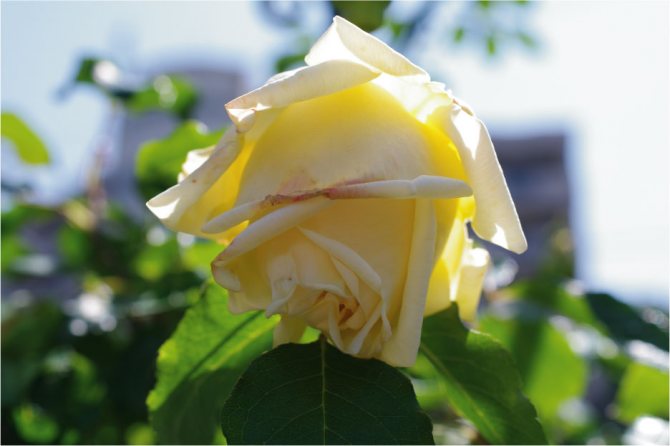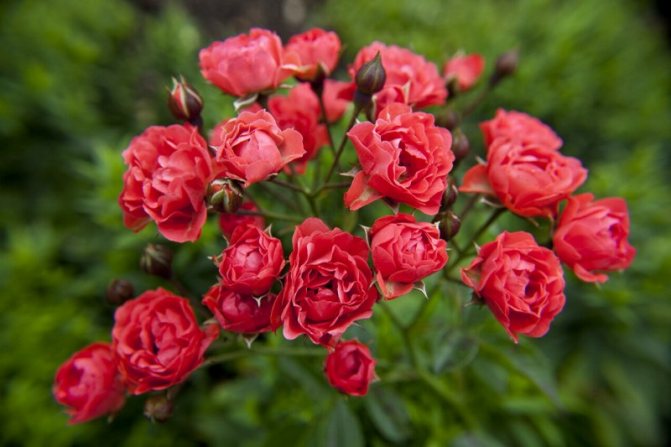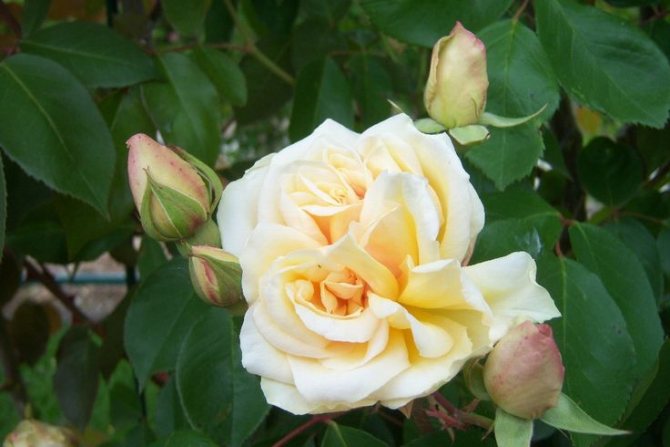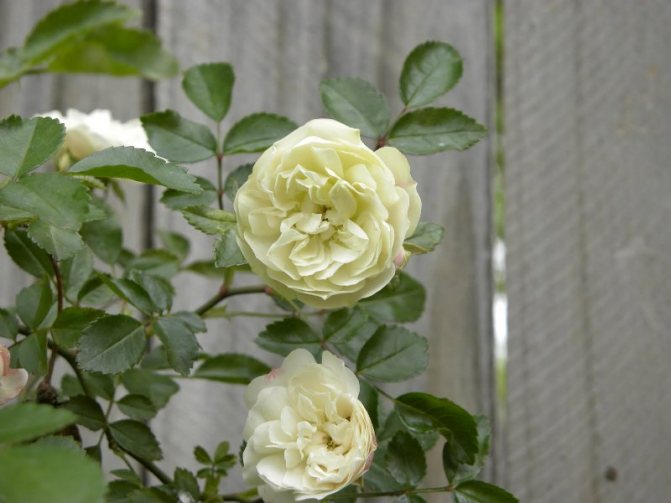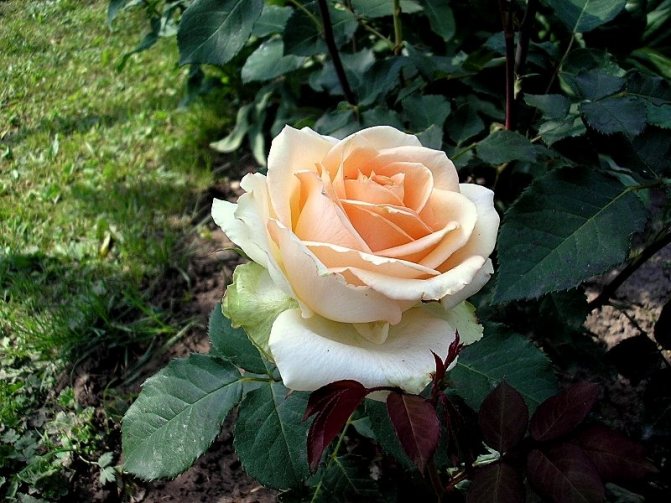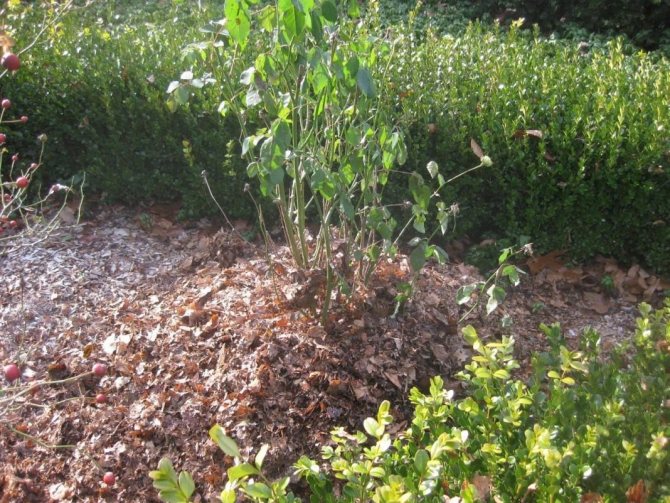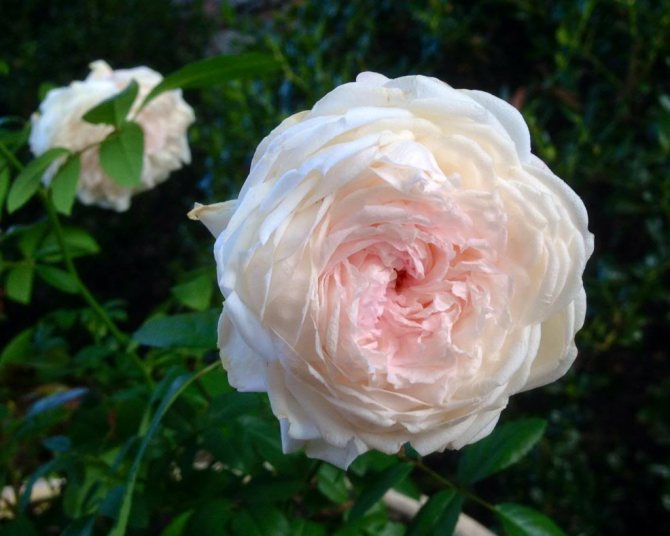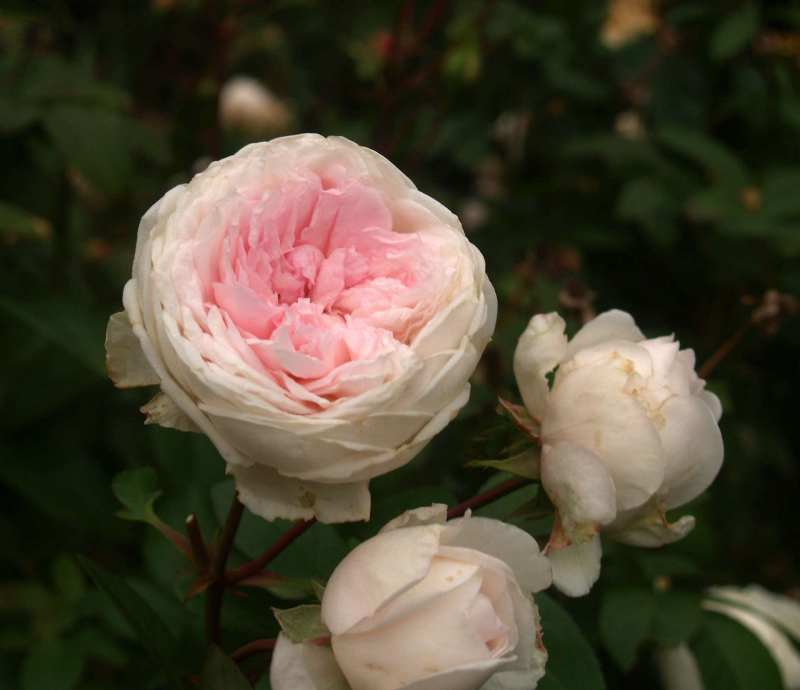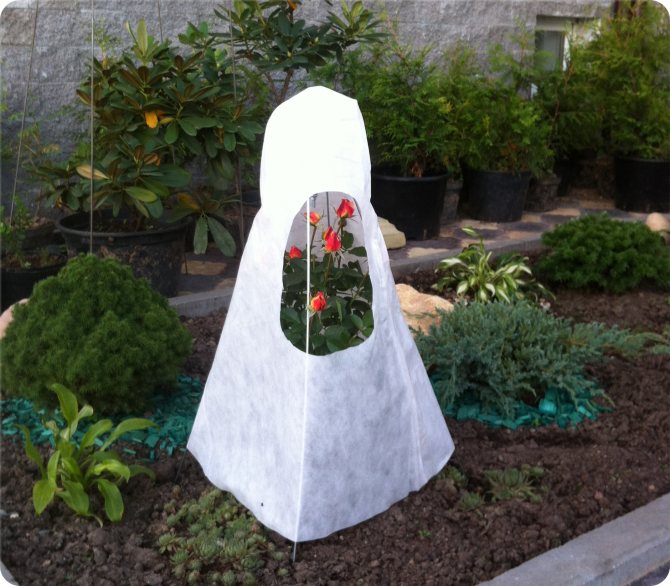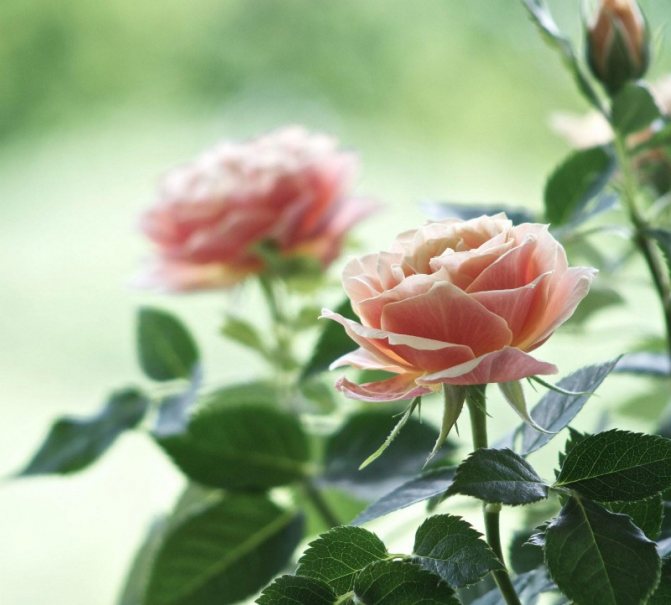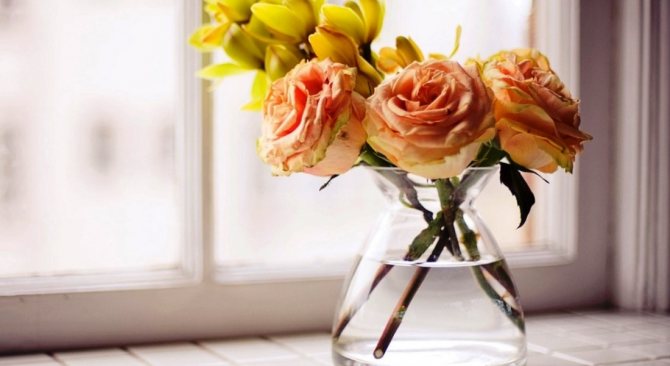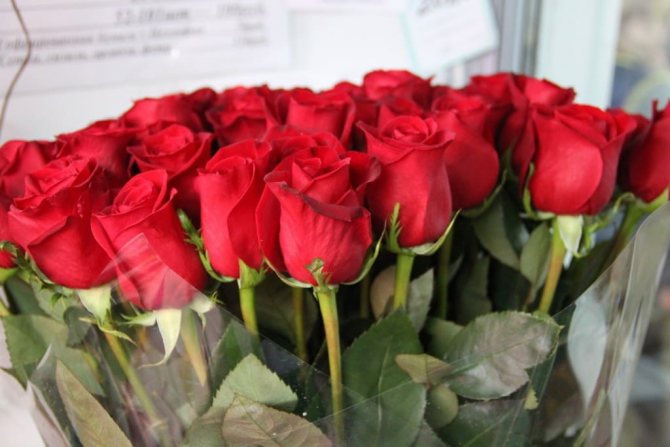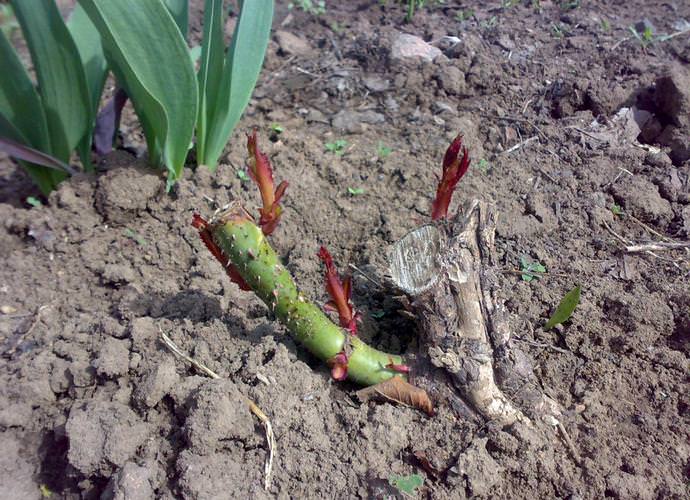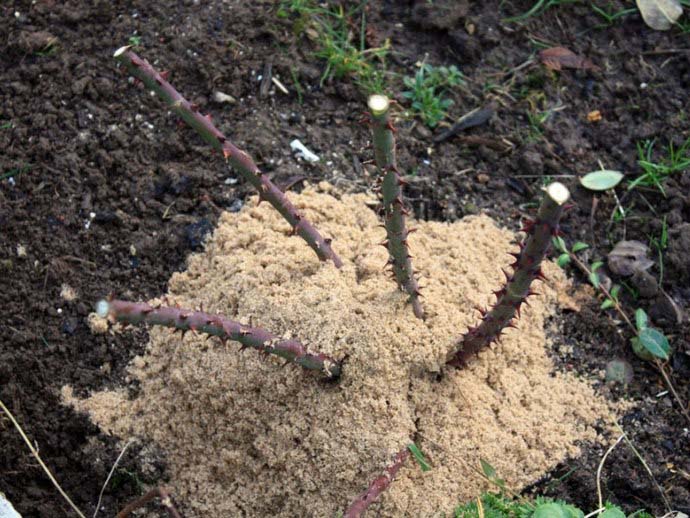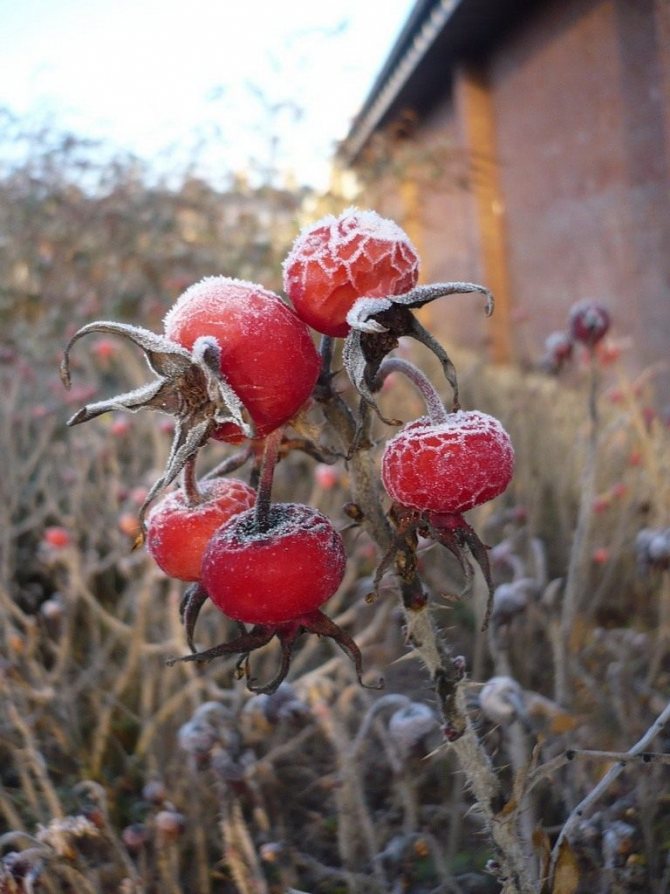One should think about the safety of roses in winter when purchasing them. Don't buy greenhouse roses, they are often sold in spring and early summer after winter forcing. Such roses themselves may not be winter-hardy, and their rootstocks are often not frost-resistant, especially in imported roses. It is impossible to distinguish them from garden (not greenhouse) roses in appearance. The only way out is to buy seedlings from reliable suppliers. In addition, garden roses, in turn, have varieties that are more or less winter hardiness. Many rose growers in their catalogs single out the most unpretentious roses in varietal groups of park or landscape. Such roses, in general, tolerate winters better than roses of other varietal groups, for example, hybrid tea. However, there are many exceptions.
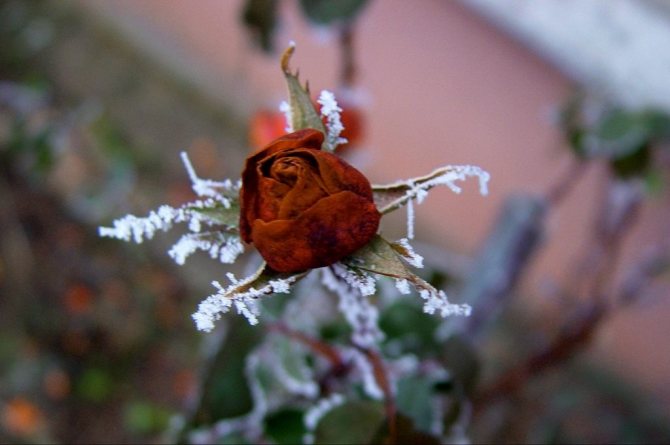
Rose in winter
Preparation
To save the bushes from freezing, start preparing for their storage at the end of September or after the first severe cold snap. Prune each shoot at the level of 0.3-0.7 m. The length that must be left depends on the age of the bush - the older it is, the more should be cut. Make sure there are 8 to 10 buds left on each plant. After that, remove all the leaves from the bush and tie the twine around the branches. It is also recommended to spray all plants with insecticide and fungicide to prevent infections.
Now you can start digging up the roses. It is known that it is better to store slightly frozen bushes. Therefore, it is best to dig them out in dry weather, when the temperature drops to + 1-2 ° C at night. In wet weather, it will be difficult to clear the roots of soil clumps. If you can't wait out the rains, dig up and dry the bushes in a warm place for 1-2 days. This will help remove any excess soil.
If you need to transport roses or your basement is far away, tie a rope around the bushes (this will help prevent branches from breaking off).
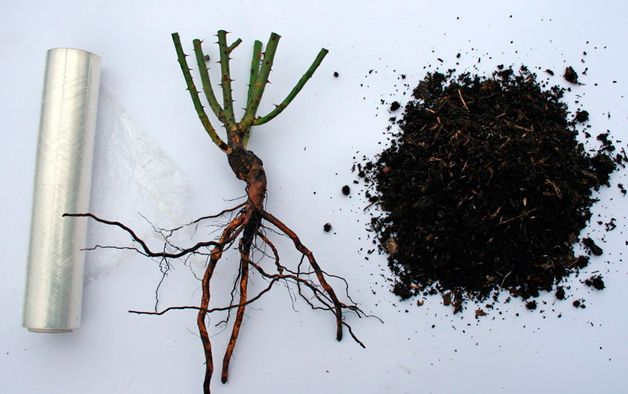

A seedling prepared for storage.
After digging up the roses, you must immediately dig up the soil in which they grew. If necessary, you can immediately treat the area with a weed killer. These measures will make it easier to plant the bushes in the spring.
The following are three of the most popular ways to store roses in winter.
- Application of containers with soil. Place the roots in plastic buckets or special containers. Several bushes can be placed in each bucket so that they stand tightly enough to each other. Fill all the free space with fertilized soil. Shake the container periodically during filling to completely cover the roots with soil. Finish with watering the roses. This method is convenient for those who plan to transport dug up roses.
- Adding sand. Many gardeners are convinced that it is best to keep plants in sand. The fact is that it retains moisture longer and prevents active growth even at elevated temperatures. Storage organization is carried out in the same way as with soil.
- Storage on shelves. If your basement is equipped with dedicated plant shelving, you don't need to use containers. To prevent the development of infectious diseases and decay, thoroughly wash and dry the racks before laying. Cover the shelves with wax paper and place the roses on top of them. Inspect them every 2-3 weeks and spray the roots with water when they are very dry.
Read also Bulgakovo Life Cottage Village
Color compatibility
It is known that some flowers are not compatible in one vase, due to the fact that some metabolic products of some flowers can be toxic to others and accelerate their wilting.
Carnations, lilies of the valley, mignonette, sweet peas, daffodils, lilies, roses are only compatible with themselves. You cannot put together lilies of the valley and violets, lilacs and violets, tulips and forget-me-nots, carnations and roses, yellow primroses and muscari. Lilies accelerate the wilting of daisies, poppies, cornflowers. Sweet pea roses and lilies of the valley will not live long in one vase. Twigs of geranium, thuja, woodruff, on the contrary, help keep flowers fresh longer.
The art of combining flowers in one composition is determined not only by their symbolic meanings or purely aesthetic considerations, but in many respects by the biological compatibility of different plants.
Go back to the main page
Storing cut flowers
Most cut flowers last best around 5 degrees Celsius. That is, even an ordinary household refrigerator is suitable for storing them. The shelf life, on average, is 5 days, although, of course, fresh flowers have individuality, and the permissible shelf life for different flowers will not be the same.
For example, for irises or tulips during storage, it is desirable to lower the temperature to 2 degrees, and for symbidium orchids (the most common orchids that can be seen on sale) and anthuriums - increase to 8 degrees. However, follinopsis orchids should be kept at room temperature. Tulips, chrysanthemums, carnations are kept dry in the refrigerator, while most flowers are best “connected” to water supply immediately by immersing the end of the stem just cut with a sharp knife into any, even a very small, reservoir of water.
After the end of the preservation period, flowers should be trimmed obliquely again before being placed in a vase. All leaves that get into the water must be removed. For all cut flowers, albeit to varying degrees, draft, direct sunlight, ethylene gas emitted by fruits and wilting parts of plants are destructive. The life of most flowers, as a rule, can be prolonged with the help of special products (for example, krizal), which are sold in flower shops in powder or dissolved form. In order not to burn the plant stems, we recommend that the powder be completely dissolved in a small amount of water beforehand.
rose flower - storage temperature - 5 degrees. For storage, the roses should be tightly wrapped with their heads in wrapping paper and immersed in a standing position in the water as deep as possible, but so that the heads do not fall into the water. If you do not plan to store the roses, anyway, before putting them in the vase, it is advisable to water them using the same wrapping method and keep it there for at least three hours. For roses, it is better to use boiled or raw, settled water with a chrysal. Thorns falling under water should be broken off. It is best to make the cut through which the food enters as long as possible. If no chrysal has been added to the water, it is better to change it once a day, each time updating the cut of the flower stem. A fresh rose can last for 30 days if properly cared for, but the rose is extremely sensitive to air bubbles and bacteria that make it difficult to absorb moisture, which often leads to rapid wilting at home.
Carnation - storage temperature - 5 degrees without water. Carnation is a hardy flower and can last for about two weeks without any special maintenance. The water in the vase should be at room temperature. If you do not use krizal, add an aspirin tablet, its effect will gradually increase the decorative effect of the carnation.
Iris highly dependent on moisture. Make sure that the iris is as small as possible without water. The optimum storage temperature is 2 degrees.And even when placing irises in a vase, keep the water chilled with ice cubes. Flowers should not be placed too deep in the water to prevent rot formation. Chrysal prolongs the life of a flower.
Narcissus - storage temperature - 2–5 degrees. The juice released into the water by daffodils is harmful to other flowers. If you want to put daffodils together with other flowers, let them stand separately for a day beforehand.
Tulip - storage temperature - 2–5 degrees without water. He loves very cold water, it is possible with pieces of ice. The stem of a tulip just placed in water tends to bend. If you do not want the flowers to stand in a vase, bending arbitrarily in different directions, hold the tulips for several hours in water with the stems fixed. Fixation can be done with paper, tightly wrapping the stems with it.
Freesia - storage temperature - 2–5 degrees. Freesia is highly dependent on moisture.
Anemones for storage, they should be freed from the cellophane wrapper in which they are sold, the stems should be cut and placed in an upright position in a solution with a chrysal. The optimum storage temperature is 2 degrees. Even at room temperature, an anemone can stand in water with a chrysal for about two weeks.
Hyacinth - storage temperature - 2–5 degrees. Hyacinth is usually sold with an onion and is best placed in a vase right with the onion.
Hippeastrum can be stored dry at 5-10 degrees. When placing a flower in a vase, we recommend filling the stem with water and plugging it with cotton wool. Hippeastrum can stand in the vase for a week or more, gradually opening the buds.
Pion - storage temperature - 5 degrees. If you need a tight peony bud to bloom right in front of your eyes, put the flower in hot water.
Mattiola - storage temperature - 8-10 degrees. The use of krizal prolongs the life of the plant. The flower is sensitive to ethylene. The container in which the matthiola will stand must be well washed. It is important to monitor the purity of the water and change it as needed.
Gerbera - storage temperature - 5 degrees. It should be placed in water not deeply and during storage and in a vase: the filling height is 4–5 cm. It is useful to rub the cut of the stem with salt. Gerbera stems, like tulips, are prone to bending. Here you can use the same methods for fixing the stem.
Lily - storage temperature - 5 degrees. A fairly unpretentious flower, it costs about a week; at the same time, new buds are gradually blooming in the lily, and the old ones die off. Lily does not require special care, but is susceptible to ethylene.
Dahlia - storage temperature - 5 degrees. The dahlia will stay in the vinegar water longer. Before placing in a vase, the stem should be filled with water and plugged with cotton wool.
Gladioli - storage temperature - 8-10 degrees. Cut gladioli continue to grow, tending to the top of the head. Therefore, if you put them horizontally, the stem may bend. Gladioli are highly water dependent.
Alstroemeria - storage temperature - 5 degrees. Alstroemeria is a persistent flower - it lives for about two weeks and does not require any special care.
Cymbidium orchid - storage temperature - 8-10 degrees. Remains decorative for two weeks, and sometimes more. Water droplets on the flowers can cause stains. Sensitive to ethylene gas. Individual flowers, placed in regular water, last longer than the branch in the test tube with which they are usually sold.
Anthurium - storage temperature - 8-10 degrees. Refers to long standing flowers. It is best to place the anthurium slice in an individual test tube with a special solution. Anthuriums supplied from Holland are placed in such a tube immediately after cutting. The cut may turn brown from time to time, in which case the flower should be pruned.
Ornithogalum - a very persistent flower on a long graceful stem with gradually blossoming buds, acquiring maximum decorative effect after about a week in a vase. These flowers do not require any special care.
Bouvardia very dependent on water. Afraid of drafts. Ethylene gas intolerant. Storage temperature - 8-10 degrees. Chrysal can be used to prolong life.
Eustoma - storage temperature - 8-10 degrees.
Euphorbia - the optimum storage temperature is 8 degrees. After cutting, we recommend that the trunk of euphorbia be immersed in boiling water for a few seconds to stop the loss of juice. This will extend the life of the plant. The plant is sensitive to ethylene gas. Euphorbia can shorten the lifespan of other flowers placed in the same vase with it.
The lilac you should remove all the leaves and break the tip of the trunk with a hammer - this will somewhat extend the very short life of the cut lilac.
Wildflowers they will live much longer if you put them in water with a chrysal, after removing the leaves that fall under the water, and renewing the cut of the stem.
On holidays, many receive a bouquet of roses as a compliment to a gift. This flower is able to tell about its feelings with just one color. And when you want to extend the life of these excellent plants, enjoy their company longer - after 3-5 days, unfortunately, the roses fade. Many simply violate the elementary rules for caring for bouquets and therefore quickly part with them. But in fact, it is enough to know a few simple rules on how to store cut roses.
Having received a gorgeous bouquet of roses as a gift, follow the recommendations and you will probably be able to extend the life of beautiful flowers at home up to several weeks.
- Do not rush to remove the packaging from the bouquet. Let the flowers stand in new conditions, at a new temperature, for a couple of hours.
- There is no need to immediately arrange a bouquet in a vase. First, the roses need to be given a drink. To do this, they can be placed in a bucket or other container so that all the leaves and stems are submerged in water. Many people immerse them in a cool bathtub.
- Now you need to cut off the bottom leaves, to the water level. You also need to trim the leg.
- It is better to store roses in ceramic vases, this material is the best for keeping water fresh.
- Add a teaspoon of sugar to the water to provide nourishment to the roses.
- To maintain freshness, you can put a couple of regular aspirin (acetylsalicylic acid) tablets in the vase.
- If the roses have been chemically treated to prolong their freshness (this fact can be recognized by the lack of scent in the flowers), add a couple of drops of dish detergent or bleach to the water.
- Keep flowers out of direct sunlight.
- If roses stand in the room, it must be ventilated. Do not keep roses where people smoke or prepare food.
- Spray the bouquet daily with a spray bottle.
- In summer, the water must be cool.
This instruction applies to roses purchased from a florist. As for the flowers cut from the bush, the rules for storing at home are slightly different.
Roses cut in a flower garden should be stored under the following conditions.
- It is best to cut the flower in the morning.
- An unblown bud is suitable for cutting.
- It is necessary to remove the thorns and leaves at the bottom of the stem, cut the stem at an angle, it is better to do this right in the water.
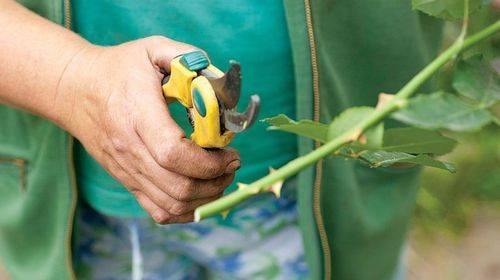

- The water should be settled for several hours or of natural origin - rain, melted snow, from a well, a spring. The water temperature should not be too low, closer to room temperature.
- Different varieties of roses must be stored separately.
- If you plan to donate or sell cut flowers, remember at what temperature you can store roses. Some people use a household refrigerator for this or take it out to the balcony. But for this, you need to clearly know at what temperature to store roses on the balcony. The ideal temperature for storing roses is 8 to 10 degrees.If the temperature drops below 5 degrees, the flowers will freeze and die.
- For storage and extension of life, cut roses at night can be placed in the refrigerator, after wrapping the bouquet in paper. Newspaper or similar.
- If cut roses are being prepared for planting, they should be stored in a cool, dark place. A household refrigerator is ideal for this. At temperatures below 5 degrees, you should not store roses in the refrigerator. Immediately before planting, flowers that have sprouted for a short time must be kept at room temperature. With sudden changes (from the refrigerator to the garden), the flower may die.
It is best to place flowers in a separate, empty refrigerator rather than with food. But if this is not possible, empty the lower shelves and be sure to wrap the flowers in newspaper.


All of the above guides have an excellent effect and allow you to prolong the life of wonderful flowers that will delight and create a great mood for a long time. Or remind of a loved one, dear person and his feelings.
Wintering in the basement or cellar
Plants are placed in the basement or cellar in early October. It is important that the temperature at the storage location is + 2-4 ° C, and the humidity is 90-95%. Under such conditions, the roses will not freeze, remain sufficiently moisturized and retain all their original properties. If there is more than + 5 ° С in the basement, they will continue to grow and bud.
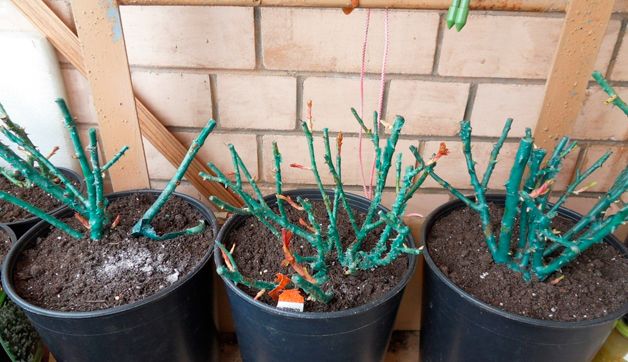

Seedlings in plastic containers with soil.
Also, the room temperature must not be allowed to drop below 0 ° C. This can lead to freezing of the soil and icing of the roots. In this case, you should immediately increase the humidity and temperature artificially using a film or other insulation. The protection should be removed at the first sign of warming.
If the temperature has exceeded + 5 ° С, it is necessary to immediately lower it. To do this, you can water the plants with cold water. You can also bring snow or ice into the room. They are laid separately from the bushes. If you pour snow between them, then the roses will quickly become covered with mold.
Remember that successful storage can only be carried out in a dry, clean and well-ventilated place. If there is mold, insects, or rats in the basement, do a thorough disinfection and cleaning first. Otherwise, the roses may get sick and not survive the winter.
Site requirements
In addition to properly processing flowers and placing them in a vase, take care of where to store the roses. There are several requirements for the storage conditions of these plants:
- choose a ceramic and opaque vase, glass will let in the sun's rays;
- the lower the storage temperature of roses, the longer the flowers will stand;
- the place where the vase of flowers will stand should be cool and protected from direct sunlight;
- you should not put the bouquet next to radiators or stoves, as high temperatures will lead to its rapid fading;
- also, do not leave plants in places where there are drafts;
- cigarette smoke and exhaust fumes have a detrimental effect on the freshness of roses and tulips;
- it is not recommended to put other flowers next to roses, as well as place them next to fruits.
Storage in the refrigerator and on the balcony
If for some reason you cannot organize storage in the basement, you should not give up growing roses. Indeed, in order to store them in winter, you can use a refrigerator or a regular balcony in a city apartment.
If your balcony or loggia is not insulated, and the average temperature on them is 0-5 ° C, you can store roses in the same way as in the basement. On an insulated balcony, the temperature in winter reaches 10-12 ° C. To prevent overheating, moisten roses once every 2 weeks with cool water and open windows more often. In this case, feeding is not necessary.
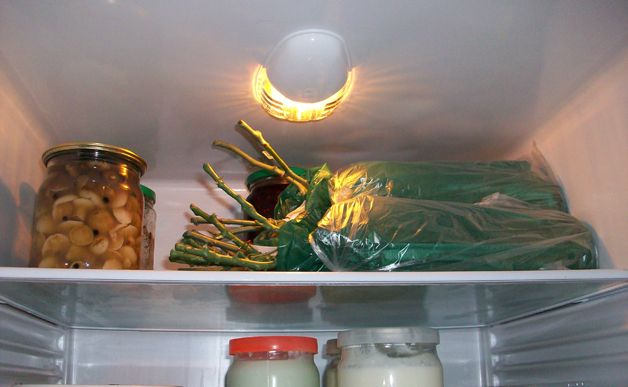

Storage of seedlings in the refrigerator.
Before you start storing roses in the refrigerator, make sure that it is set to the right temperature. In addition, the humidity in the refrigerator compartment should be 90-95%. After making sure that your performance is within the recommended range, pack the prepared bushes in plastic bags. Do not tie them too tightly, let the plant breathe freely.
Place the plants tightly against each other on the shelves. Open the bags once a month and check the roses for moisture and mold. If necessary, spray the roots with a spray bottle and remove mold with a soft brush or cloth. If the roses start to rot or show signs of infection, remove the bad plants immediately. In the future, monitor the storage conditions and condition of flowers more carefully.
Storage tips for roses
When the water for the roses has already been prepared, you can start preparing the flowers themselves. It does not really matter at what temperature the roses are stored, but a sudden change from cold to warm will have a bad effect on them. Therefore, in winter, you cannot bring a bouquet of flowers directly from the street into the house. You need to give them time to acclimatize, leaving them for a while in the corridor or other cool room, and only then bring them into the home. In the house, let the roses stand a little in the package, after which it should be carefully removed.
But even after the plants have adapted to home temperature, you cannot simply lower the bouquet into a vase without examining and processing the flowers. For a long time, only fresh roses can stand in the vase. Small green leaves that are under the buds will help determine the freshness of the flower. In fresh roses, they adhere closely to the heads, and if the leaves are already lowered or sluggish, such a flower will not stand for a long time. Such plants need special treatment.
Place fresh roses in a container of water at room temperature so that they are saturated with liquid. This can be a bucket or a bathroom, but flowers should be placed in such a way that water does not get on the petals, as this can lead to their rotting. After 2-3 hours, cut the stems at an angle and split at the cut. This procedure is best done without getting the stems out of the water. So the roses are well nourished with water, and as a result, they will retain their freshness for a long time. If the cut of the stem is made perpendicularly even, then it will abut against the bottom, which will prevent moisture from entering the cut.
Roses will stay fresh much longer if you remove the thorns and leaves from the stem, which will be in the vase under water. It is these parts of the stem that most quickly rot in the water and lead to the rapid wilting of the plant. It is recommended to cut the thorns and leaves on the greater half of the stem and pick up a vase of the same height.
Recommendations on how to store roses for a long time will come in handy if you prefer to buy flowers for the holiday in advance. If this is the case, cut off the stems at an angle and place them in room temperature water for 2 hours. Then put the bouquet in the refrigerator overnight, since the cold slows down the metabolism in plants, they will last longer. The next day, the roses will remain as fresh.
Planting bushes
Regardless of which way you choose to store the rose, the planting rules are the same. In the spring (on the twentieth of April), you need to get roses from the basement or refrigerator. Examine them carefully. If mold appears on the leaves or roots, carefully remove it with a cloth moistened with a weak solution of copper sulfate. If the storage was carried out correctly, the roses will have the first buds and young shoots.
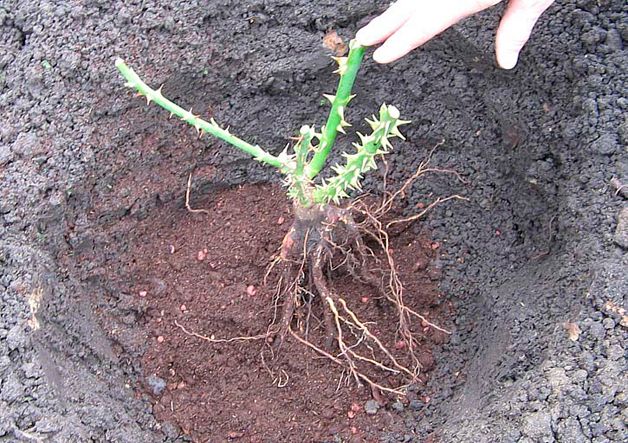

Correct planting of the bush.
Remember to moisten the soil regularly before planting. Usually overwintered roses are planted in mid-May. If the weather is not warm enough, wait another 1-2 weeks.
Fertilize planting holes or dig up the ground by adding manure to it.Water the planted bushes immediately and loosen the soil around them slightly. Arrange top dressing 2 times in the first month after planting. At this time, roses will actively develop and give new buds. If you do everything right, then by mid-June they will bloom.
Thus, storing roses in winter requires a fairly long preparation, but you will definitely like the result. Choose a storage method depending on your capabilities and follow all the recommendations given in this article. Beautiful and strong plants will delight you with their flowering for many seasons.
Agronomist-plant grower, site consultant on the cultivation and storage conditions of vegetables, fruits and mushrooms.
Roses can become a truly royal garden decoration in summer and fall, but without proper care of these flowers in winter, you can hardly enjoy fragrant buds next year. Roses are very sensitive to cold weather, so you need to prepare them for winter in advance, and it is advisable to inquire about caring for the crop in the cold season even when buying.
In this article, we will show you how to preserve roses in winter and how to prepare these moody flowers for the cold season. You will also learn about the most effective and reliable ways to cover bushes that will help protect your crop from frostbite and disease.
If the seedlings "woke up"
The presence of living buds on a plant indicates its "awakening". You can save such roses until planting on the balcony. But if the growth of shoots is observed, then it is important to create all conditions for the normal development of a bush or cutting:
- The plant is freed from packaging or from wet paper in the case of cuttings, the name of the variety is attached to the stem.
- The roots are soaked in heteroauxin or Kornevin, following the instructions.
- A large container is selected for planting a rose (at least 5 liters) with a drainage system. For further planting in late spring, you will have to trim the bottom and side of the pot. Thus, it will be possible to preserve the roots of the plant and the earthy clod, which will have a positive effect on the future health of the flower.
- Choose a sunny or artificially lit place in the apartment. If possible, the pot is placed in a greenhouse in April.
- When planting in the spring, you need to monitor the safety of the earthen coma. If its integrity remains unchanged, then it is not at all necessary to remove the buds. Otherwise, you will have to cut off all the buds and flowers.
With proper care of seedlings, roses will be able to please gardeners with their flowering already in the year of planting.
How to keep roses in winter
The successful cultivation of roses over several seasons depends largely on the variety. In particular, it is not recommended to buy greenhouse flowers, which often go on sale in early spring after winter forcing. Such varieties and even their rootstocks are not frost-resistant, and even with a high-quality shelter, they can die over the winter (Figure 1).
Note: This also applies to imported varieties, which are distinguished by an unusual flowering and shade of petals, but are completely unsuitable for growing in our climate. Therefore, if you want to decorate your garden with these bushes, give preference to domestic varieties and hybrids.
In order for your flowers to successfully overwinter, you need to consider several important parameters:
- Plant dimensions: the type of shelter will depend on the height and spreading of the bush. For example, miniature and ground cover varieties are easy to cover, so novice growers prefer to grow them. Tall, upright and climbing varieties will need more capital shelter.
- Location: if you do not have enough time to care for the garden, but you still want to grow the queen of flowers, try not to place them one by one in different parts of the garden. The fact is that it is much easier to cover the bushes planted in a group than many single plants.
- Boarding time: if you are planting a sprout in late summer or autumn, in no case apply nitrogen fertilizers to the hole. They stimulate the growth of shoots, but the culture may not have time to fully take root before the onset of frost and will die. It is better to leave this kind of top dressing until spring.
Read also Unripe melon what to do


Figure 1. In winter, the queen of flowers needs special attention from the owner
If you have already managed to enjoy the flowering of bushes in your garden, keep in mind that after the end of this period, you should start actively preparing the plants for winter. This will determine how successfully this capricious culture will endure the cold.
How to prepare roses for winter
It is worth thinking about preparing for winter at the end of summer, when the flowering period ends. It was at this time that the introduction of nitrogenous fertilizing should be stopped so that the plants do not increase the green mass and do not weaken before the arrival of cold weather. It is better to leave this kind of top dressing until spring. But potash fertilizers applied in small quantities will not harm garden varieties at all. They will help make branches and shoots thicker, which plays an important role in successful wintering (Figure 2).
Note: With the arrival of autumn, it is necessary to stop any loosening of the soil on the near-stem circle, as this can provoke the growth of young shoots, which will weaken the plant.
Pruning is a mandatory step in preparing for winter. But, since this procedure has its own characteristics, we will consider it in a separate section. In addition, you need to completely remove plant residues from the trunk circle: grass particles, fallen leaves or branches. This has not only aesthetic, but also practical value. If you leave plant residues under the bush, they will rot during the winter and become a source of pathogenic microorganisms. For the prevention of diseases in the fall, it is also recommended to spray all shrubs with Bordeaux liquid.


Figure 2. Preparing roses for winter includes watering in winter, pruning and shelter
It is also recommended to huddle all the bushes with a small earthen mound 20-30 cm high. This will not only improve the supply of oxygen to the roots, but with the arrival of winter will protect the plant from freezing. When all the preparatory activities are completed, you can proceed to the direct shelter of the culture.
Pruning roses for the winter
For most garden varieties, pruning is a must in the care and preparation for winter. The only exceptions are climbing, park and ground cover species with miniature buds (Figure 3).
Note: Regardless of the type and variety, formative shortening of branches is mandatory in spring, but autumn pruning is not recommended for all types of culture.
The main purpose of pruning in autumn is to maintain plant vitality, strengthen it and make it more frost-resistant. If you remove old branches correctly, next season the bush will be covered with completely new shoots and will give abundant flowering.
To properly cut a bush for the winter, follow these tips:
- The procedure is carried out on both old and young plants.
- All wilted buds, unripe shoots or branches with signs of disease or mechanical damage are removed from the bush. If these parts are left directly on the bush, they can cause the development of fungal and infectious diseases.
- Ideally, no more than 5 of the strongest and healthiest shoots should remain on the trimmed bush, which in the next season will give young shoots and abundant flowering.
- All removed plant residues must be burned immediately so that they do not become a source of disease for other plants on the site.
- All old branches over 3 years old, shoots with dry bark and abundant lateral shoots are also subject to removal.


Figure 3. Technology for pruning bushes
After completing all these procedures, the plant will be much more comfortable under cover.To carry out the pruning correctly and not harm the plant, you should use only a sharp instrument that has been previously disinfected. In addition, the procedure is best done just before the shelter, that is, on a sunny fine day in early November.
Storage problems
Real rose lovers have been waiting for seedlings of their favorite variety since autumn. That is why, at the first mention of the name of the plant, they try to acquire it as soon as possible. But buying early has its drawbacks.
How to preserve rose seedlings before planting so that they do not dry out or frostbite? The answer to this question is built from several factors:
- root system device;
- the presence of kidneys and sprouts;
- the time period before the onset of stable landing temperatures;
- resources and capabilities of the person keeping the seedlings.
Plants with an open root system are the most difficult to store. As a rule, these are roses sold in boxes. The roots of such plants are often curled up, tightened for compactness and only lightly covered with earth. And the buds are just beginning to grow or have already turned into highly elongated shoots. It is better to refuse such roses right away. But, if the purchase has already been made, then you need to try to save the plant until the moment of planting in the spring.
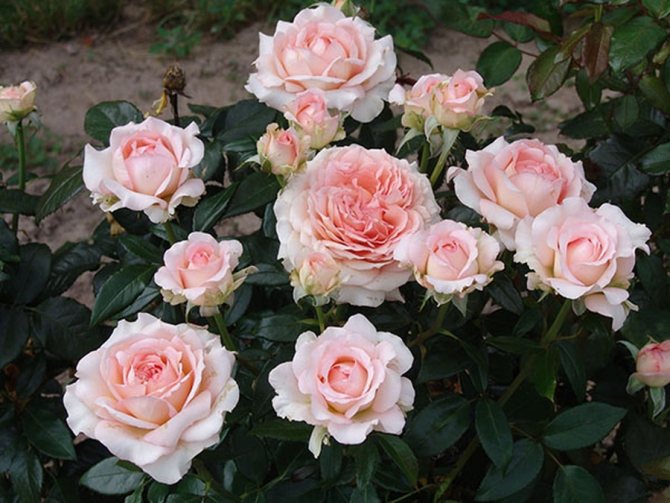

How to keep a rose outdoors in the garden in winter
Many gardeners prefer to transfer especially delicate and sensitive plants for the winter indoors, for example, in a ventilated basement. However, this is only possible with small bushes or seedlings that do not grow in open ground, but in large pots. The rest of the flowers will have to spend the winter outside, which in turn puts forward certain requirements for plant care.
In addition to cleaning the trunk circle and pruning in the fall, garden varieties will need a reliable shelter that will protect them from the cold. It is this stage of caring for ornamental shrubs that needs to be given increased attention.
Shelter methods
There are many effective ways to cover bushes for the winter. Thanks to this, each gardener will be able to choose a suitable method for himself, depending on the variety of the culture grown, the climatic conditions of the region and financial capabilities (Figure 4).
The most effective are the following methods of shelter:
- Air dry: is considered the most effective, but also the most costly method. To cover the plants in this way, around the bush you will have to build a wooden canopy made of durable boards that can withstand the pressure of snow. As a support for the canopy, you can use posts made of beams or bricks. From above, the canopy is covered with non-woven material and fixed on the surface of the ground with bricks or stones. The height of such a shelter, which depends on the variety, also plays an important role. For example, for climbing varieties, the height of the structure should be 60-80 cm, and for all others - 30-60 cm. It is important that you have the opportunity to gently bend the branches to the ground without the risk of breaking them.
- Using natural materials: spruce branches are best suited for this purpose, which perfectly protects the culture from frost, but at the same time does not interfere with free ventilation, so the shoots will not rot or rot.
- Using roofing material: this method is in many ways similar to air-dry, since at first a frame is made around the bush of wooden planks or boards, and then it is covered with a piece of roofing material of a suitable size. The advantage of this material is that it perfectly protects from cold and moisture, but at the same time does not lead to damping off of plants.
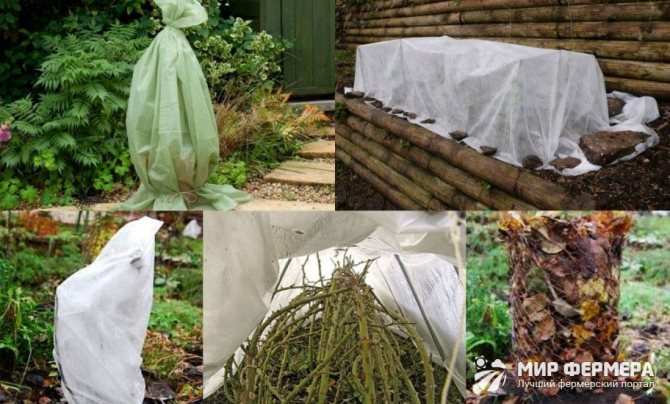

Figure 4. Options for shelters from various materials
In addition, the bushes can simply be gently bent to the ground, fixed on the surface with thick wire and sprinkled with dry leaves or soil, with a layer of 15-20 cm, although any natural material with similar properties can be used instead of leaves.The only thing that is not suitable for shelter for the winter is a dense plastic wrap. Despite the fact that it protects well from frost, it does not allow air to pass through at all, therefore, under such a shelter, flowers can die from high humidity during the winter.
Read also Red geranium in the house of signs
Protection against diseases in winter
Many gardeners believe that in winter, due to the low ambient temperature, nothing threatens roses, because pathogenic microorganisms do not spread in such an environment. But this opinion is erroneous, since certain diseases can affect bushes even in winter.
Note: In late winter and early spring, when the ambient temperature rises slightly, plants can suffer from a fungal disease - an infectious burn.
It is difficult to miss the symptoms of the disease: characteristic dark brown spots appear on the trunks and branches of the plant, which gradually capture new areas of healthy tissue. If measures are not taken in time, the plant may completely die. The only option to prevent the disease is the modern removal of the shelter. You should not wait until the snow has completely melted: as soon as a stable, albeit small above-zero temperature is established, the shelter can be slightly opened. This will allow fresh air to flow inside, and the fungus simply cannot develop.
If you are not sure that you will be able to open the bushes in time after wintering, treat them with fungicides in the fall. For this purpose, iron or copper sulfate is perfect. In addition, during the preparation of the bushes for winter, they can be covered with clean sand. For this purpose, in no case should you use the soil from under the bush itself, since such soil may contain spores of dangerous fungi or other pathogenic microorganisms.
Lapnik as protection for roses
Pine or spruce branches (spruce branches) are considered the best shelter for roses for the winter, because this natural material not only perfectly protects from frost, but also allows the plants to breathe under the shelter (Figure 5). It is the last point that is key, because with a lack of fresh air and high humidity, the shoots can begin to rot.
The advantage of spruce branches as a shelter is also that the needles contain essential oils that have bactericidal properties. This means that your garden rose under such cover will receive additional natural protection against infections and fungi.


Figure 5. A paddle is considered a versatile material for shelter
In order to properly cover the rose with spruce branches, the shoots of the culture must be bent to the ground, fixed on the surface with thick wire and covered with spruce branches. When the snow falls, it will cover the roses and provide them with additional protection from frost. If possible, you can additionally sprinkle the structure with snow.
Which way to hide roses to choose?
It is up to the gardener himself to decide which of the cover methods to use, but for this he needs to keep in mind the following considerations:
- in the cold period (and not only in winter) roses can be damaged by frost, affected by pathogenic fungi, branches can break both during shelter and under the weight of snow;
- a large, well-prepared for winter rose in the middle lane will almost never die, even without shelter (the exception is “black” frosts, when, due to the lack of snow at the beginning of winter, not only the aboveground, but also the underground part of the bush can freeze out);
- a rose that has emerged from wintering with large losses of the aboveground part weakens greatly, and already next winter may be the last for it (the plant does not have time to grow the aboveground part during our short northern summer); the gardener's task is not just to keep the rose alive, but to preserve, if possible, its aboveground part;
- in the fall, roses gradually prepare themselves for frost (according to my observations, the critical temperature for hybrid tea roses in mid-September is -5 ° C, in mid-October -7 ° C, in the first half of November -10 ° C, in the second half of November - about -15 ° C and even -18 ° C);
- pruning roses (not only for the sake of flowers, but also for shelter for the winter), premature wrapping of the bushes not only stop the natural process of preparing roses for frost, but can also completely deprive the plants of the acquired hardening, especially if there are many warm days in the fall; the rose recklessly comes to life, even a light frost can destroy it;
- if you leave the set fruits on the bush after flowering at the end of summer, the plant no longer "thinks" about the new growth of shoots, the buds do not wake up, and such a rose winters better.
How to keep roses in the cellar in winter
If you grow rose varieties that do not have a large crown volume, you can easily store them in a ventilated cellar. To do this, in the fall, you need to prune the shoots and leave the plants in the flower bed for a while. When the night temperature drops to + 1 + 2 degrees, choose a dry sunny day and dig out the bushes from the ground.
Note: This method is due to the fact that slightly frozen rose bushes are much better stored, and it is easier to dig them out of the ground.
Immediately after you have removed the bushes from the ground, they must be placed in a container for storage:
- Container with earth: one or more bushes are tightly set in a bucket or any other container, and the remaining space is covered with soil so that it completely covers the roots. Then water the plants and transfer them to a storage room. This method is perfect not only for preserving bushes, but also for transporting them (Figure 6).
- In sand: many growers are sure that rose bushes are best stored in dry sand, as it retains moisture much better and prevents seedlings from releasing young shoots. The storage technique remains the same as for land use.
- On the shelves: if your cellar has special racks for storing plants, containers with earth or sand can not be used. The shelves on which the roses will be located must be washed, dried and disinfected. Next, cover the shelves with wax paper and lay out the roses. In the future, the condition of the plants should be checked every two weeks and, if necessary, the dried roots should be sprayed with water.


Figure 6. Methods of storage in the cellar
If you are going to dig up roses for further storage in the cellar, do not forget to dig deep into the soil in which the bush grew. This will help destroy the larvae of pests or pathogens that may have remained in the soil.
Soil preparation and planting
An area well-lit by the sun and ventilated, without stagnant groundwater, is suitable for roses. The land should be loose and fertile. Prepare the soil a few weeks before planting. It should include the following components:
- clay;
- humus;
- compost;
- mineral fertilizers.
Fresh manure must not be added to the ground, as it damages the delicate roots of plants. Choose high quality seedlings with a well-developed root system and strong shoots. The day before placing them in the ground, remove the damaged and immature processes. It is recommended to shorten the aerial part to 35 cm, and the roots to 30 cm. Rotten areas are also cut off.
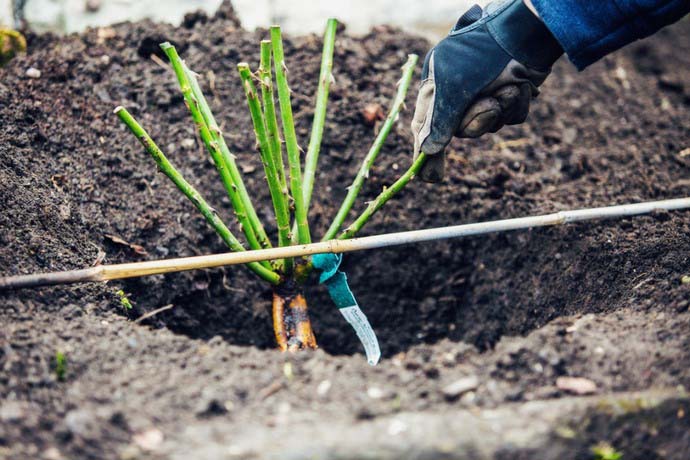

Experienced gardeners advise to disinfect rose seedlings by spraying them with a solution of ferrous sulfate.
The depth of the hole directly depends on the height of the seedling; its roots should fit freely into the hole. Climbing varieties of roses deepen even more in order to form additional roots.
With proper planting, the root system of the seedling is straightened, and the soil is well compacted and does not form air cavities. At the base of the bush, fill the earth with a slide in order to protect it from the cold.
How to store roses in the basement in winter
The basement under the house is also great for winter storage of roses, and the technology remains about the same as when placed in the cellar. At the same time, it is important to strictly observe the timing of plant placement and the microclimate of the room (Figure 7).


Figure 7. Basement storage should be dry, moderately warm and humid
In order for the culture to feel normal throughout the winter, it is advisable to maintain a temperature in the basement of the order of + 2 + 4 degrees. In this case, the humidity should be 90-95%. In such conditions, the roots and shoots will not freeze slightly, will remain sufficiently moist, and the plants themselves will retain productivity and vitality. If the temperature in the basement rises to at least +5 degrees, the roses will begin to sprout, which is highly undesirable during winter storage. If the temperature drops below freezing, the soil and roots may freeze, and you will have to make additional efforts to reanimate the bush.
In what conditions are flowers stored in a flower shop
Storing flowers in a store requires special care, since the slightest mistake can lead to the death of the entire product. So, the most important thing in keeping roses in any conditions is a systematic change of water.
If this is not done, there is a danger of the activation and spread of putrefactive bacteria.
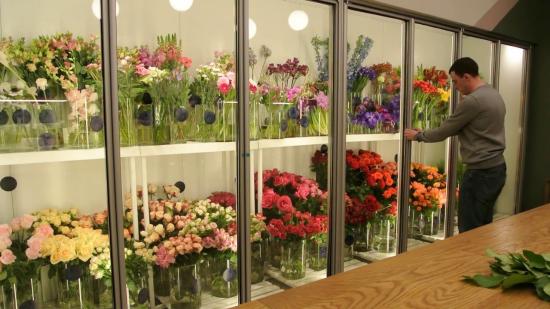

In addition, in stores to keep plants in good shape:
- One drop of bleach is added to the water to stop the decay. In this case, the water must be cool;
- Before placing the bouquet in water, the ends of the stems are split, and the lower leaves are carefully cut off. Sometimes the cut is scalded with boiling water;
- Every evening, roses, as plants are quite capricious, refresh: they remove the lower leaves and thorns, refresh the cuts;
- The water in the vase should be cold enough to cover the stems. Since cut plants need cool air, flowers are kept at the optimum temperature;
- In addition to a special powder, or an aspirin tablet, half a streptomycin tablet mixed in three liters of water can maintain a fresh look. Such mixtures prevent the formation of putrefactive bacteria that cause rotting of the stems.
A flower shop is a place where cut plants are looked after by experts. If the maintenance rules are not followed, there is a risk of losing the entire product.
How to save cuttings of roses in winter for planting
If during the summer time you managed to prepare enough cuttings for planting new plants in spring, but there is no good cellar or basement for storing them, you may well save the planting material on the balcony of an ordinary apartment or in the refrigerator (Figure 8).
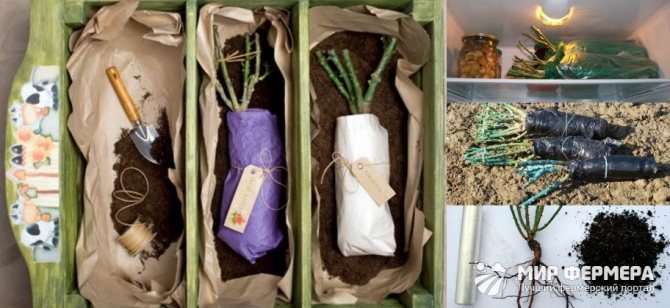

Figure 8. Methods for storing cuttings at home
For example, if the temperature on the balcony is 0 + 5 degrees, you can store roses in the same way as in the basement. If the balcony or loggia is insulated, and the temperature in the room rises to + 10 + 12 degrees, you need to open the windows more often for ventilation and periodically spray the roses with cool water to prevent overheating.
Similar requirements are put forward for storage in the refrigerator. But, in addition to the optimal temperature and humidity, it is recommended to wrap the cuttings of roses in plastic bags, but do not wrap them tightly so that the sprouts can breathe freely.
All stages of proper preparation of roses for winter are shown in the video.
How to feed roses in the fall.
There are various fall dressings for roses, we offer you 2 recipes that you can easily make yourself.
Recipe 1
In a 10 liter bucket, they are bred:
- potassium monophosphate - 16 g;
- superphosphate - 15 g;
- water - 10 liters.
Recipe 2
- potassium sulfate - 10 g;
- superphosphate - 25 g;
- boric acid - 2.5 g;
- water - 10 liters.
One bucket with such a top dressing is enough to peel roses in a 4 square meter flower bed.
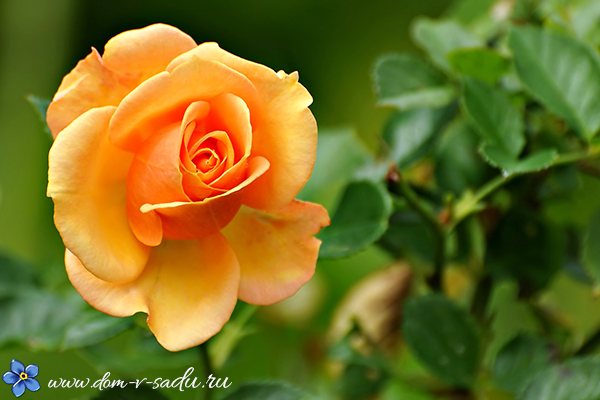

In early September, you need to inspect all the bushes and determine their condition.If the leaves are red, it means that the bush is in a state of growth and is not ready for winter. No need to pick faded rosebuds. The seeds will begin to ripen, and the bush will understand that the flowering period is over and it is necessary to prepare for winter. Next comes the stage of pruning the bush.
Roses: features of the growing season during the cold season
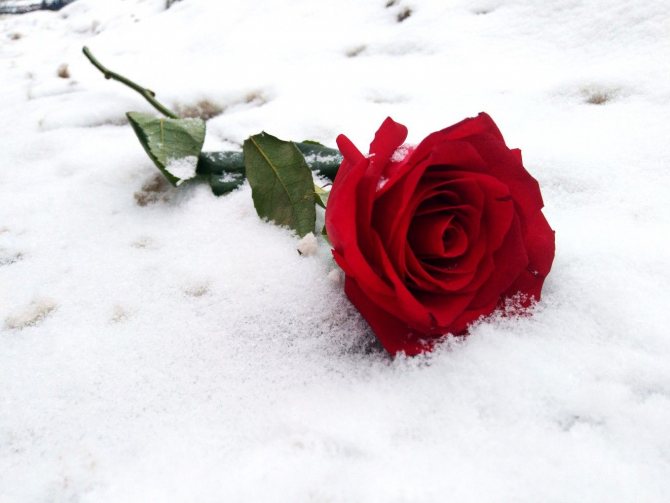

Modern varieties of roses obtained as a result of selection do not enter the dormant period along with a decrease in temperatures, unlike other perennial shrubs.
On flowers until winter, new deciduous shoots can form and flower buds can be laid, while the cold sends them to "hibernation" forcibly.
The dormant period of breeding varieties of roses is characterized by the main feature - at the slightest warming, active vegetation resumes.
Even if the temperature rises a couple of marks above 0 degrees, the sap flow will resume. In this state, the shrub is vulnerable to severe frosts, which most often cause its death.
Things to Consider When Cutting Roses
Another way to keep flowers fresh is to cut them correctly.
So, it should be borne in mind that:
- The best time to collect is the morning, no later than seven o'clock;
- When choosing, you should focus on buds that have not yet blossomed;
- It is better to cut the stem at an angle, followed by the removal of the lower leaves.
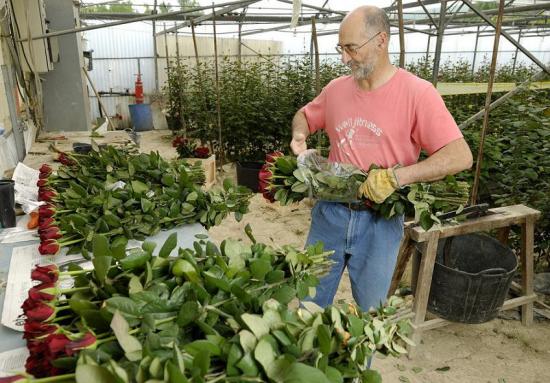

This sequence is due to the fact that overnight the buds have time to be saturated with moisture and remain fresh longer. Removing the lower leaves will reduce the risk of putrefactive bacteria growing.
How to maintain the fresh look of the bouquet is a common question that worries both industrial-scale gardeners and ordinary amateurs.
If you follow all the rules of care: a combination of moisture and the right temperature, this issue will cease to be a problem.
We recommend watching an interesting video with expert recommendations on how to maintain the freshness of cut flowers for a long time:
Diseases
Consider how to care for a room rose during an illness.
Sometimes indoor roses are affected by powdery mildew., which can be identified by the white, like flour, bloom on the stems and leaves.
To combat the disease, the affected parts are removed and the plant is treated with a fungicide, for example, Topaz, Fundazol or Fitosporin.
Of the pests, spider mites and aphids can pose a threat to indoor roses. If pests are found, the plant should be washed with soapy water.
If there are a lot of insects, insecticides will be needed: Actellik, Nurrel-D or Fitoverm.
Cutting roses
Cut roses carried out daily, from 7-8 am to 11-12 hours.
Late spring, summer and early fall, cut roses it is better to spend it twice a day, which is determined by the degree of opening of the bud.
For most varieties roses flower ready for cut if all the petals of the bud are visible. This is usually the 2nd or 3rd stage of bud opening. According to the European classification, five stages of rose opening are determined
Cutting roses produced by a special pruner with a pressure shelf. The pruner should be sharp so that the stem of the rose does not wrinkle. If the stem of a rose is wrinkled during cutting, it makes it difficult for water to enter the stem after cutting. This results in decreased vase resistance and may also prevent the bud from fully opening.
Time from cut rose from a bush to placing it in water should not exceed 30 minutes. Otherwise, there is a blockage of the conductive bundles, which leads to the premature wilting of the rose.
Transfer
Consider how to transplant a room rose.
Young plants are transplanted annually, adults - as needed, that is, when the roots completely fill the volume of the pot.
The optimal time for transplanting a room rose is at the end of autumn.
The pot is chosen 3-4 cm larger in diameter and 5 cm deeper than the previous one.Since the root system of a room rose is very fragile, the transplant is carried out by the transshipment method, without disturbing the earthen coma. After transplanting, it is better to put the flower in the shade for a while.
For transplantation, drainage and a soil mixture for roses are being prepared, into which it is desirable to add complex fertilizer.
A drainage layer with a thickness of at least 3 cm is laid at the bottom of the pot.
A new flower pot must be rinsed well if it has been previously used to grow indoor flowers. A new ceramic pot does not need to be washed, but should be soaked in water for several hours.
To gently get a rose out of an old pot, you need to water it a few hours before. Then the earthen lump with roots is removed completely, without crumbling.
The plant is placed in the center of an old pot, and fresh soil is poured along the edges. The soil is compacted. The plant should not be deeply buried. It is necessary to plant it so that the root collar is at the level of the soil.
Transplanting a room rose after purchase is possible after the end of flowering.
The soil
The soil for indoor roses should be good for air and moisture. A special substrate for roses is perfectbought in a store.
Or you can make the mixture yourself. Soil for room roses can be of different compositions:
- Sod land (4 parts), humus (4 parts), sand (1 part);
- Humus (2 parts), peat (2 parts), sand (1 part);
- Peat (2 parts), humus (2 parts), garden soil (1 part), sand (0.5 parts).
It is important to disinfect a self-prepared mixture by spilling it with boiling water. Only then can the plant be planted. A good drainage layer made of expanded clay or polystyrene is important.
Care Tips
If you want to achieve the longest possible preservation of the appearance of roses, you will need to take care of them constantly. The most important thing is to change the water every day (or at least every other day). With each replacement, replenish the flowers, add disinfectants, wash the vase thoroughly. Also wash the stems regularly and update their cuts. Spray flowers daily in the evening, but do not allow moisture to get inside the bud. Always keep in mind the quality and purity of your water. And if, after spraying, you wrap the buds in plastic bags, then in the morning the flowers will look like freshly cut flowers.
How to store roses if they start to fade? In order to admire these beautiful flowers even for a few more days, carefully put them in the bathroom with water, leaving the buds above the surface. Cover the plants with plastic wrap on top and leave for a while. If such measures did not help to refresh the bouquet, add a drop of ammonia to the water.
By adhering to these simple tips on how to store roses correctly, you can keep them fresh for a month. Remember, flowers are meant to show feelings. Therefore, if roses are presented with a pure soul and sincerely, then they will stand for a long time and without interference.
Shock therapy for wilting roses
It is possible to keep the roses fresh for several weeks, however, if the flowers begin to fade, apply the shock method that will prolong the attractiveness of the bouquet longer. A mixture of ammonia and ordinary alcohol in a small amount helps to prolong the life of flowers. Place the bouquet in a cold bath tub overnight. If placing flowers in a bucket of ice water, wrap the top tightly in paper. In the morning, cut off the ends at an angle, all leaves and thorns.


Boiling water allows you to restore severely wilted plants. Remove all thorns and leaves from the stems. Cut the end off at a tight, sharp angle. Pour enough water into the container to hide the cut. The buds won't tolerate hot steam, so cover them with a towel. Excessive evaporation must be prevented by covering the crockery.
Varieties with thin stems need about 30 seconds, thick ones immerse in boiling water for a minute.The tip of the stem will burn and darken under the influence of high temperature. Remove the damaged part at an angle and place in cold water for an hour.
Withered plants can be dried and made into a herbarium, thus, you can preserve a bouquet dear to your heart.
How to choose the right vase for a bouquet
In most cases, flowers wither quickly at home only because the housewives cannot choose the right vase for them. To avoid this, you need to be guided by the following rules when choosing a vessel for a bouquet:
- If you need to put from 1 to 5 roses in water, it is recommended to take a vase with a narrow neck, but a wide and stable base.
- If you were presented with a large bouquet, you should give preference to an oblong cylindrical vessel that you cannot accidentally turn over.
- If you have several vases of a similar shape and volume, you need to give preference to the one that will have a wider neck.
Important: special attention should be paid to the material from which the vase is made. Thus, it was noticed that cut plants are preserved for the longest time in opaque clay vessels. In transparent vases, roses of any varieties wither much faster, since sunlight penetrates well into them, which promotes the reproduction of bacteria.
As for the height of the vessel, it should correspond to the length of the flowers presented to you. Water in such a vase needs to be collected by only two-thirds of the volume - then the bouquet will receive a sufficient amount of moisture, but will not drown in it.
How to prune correctly?
In order for a beautiful bouquet to last a long time, it is extremely important to properly trim it before immersion in water. For this you need:
- Carefully cut off all the leaves from the flower below the water level in the vase. This will prevent the natural rotting of the plant in the first days.
- Cut each flower obliquely above the water. In order for it to better absorb liquid, it is recommended to divide its end into 2-3 parts. In this case, you need to try to make the area of such a cut as large as possible - this will allow the plant to receive the necessary volumes of moisture and substances useful for it.
- Rinse the stem well and roll it in a towel or a clean cloth soaked in ice water. After that, it is better to put the roses themselves in a dark place for half an hour or an hour. This technique is used even by florists who want to extend the life of a bouquet.
- Then you can submerge the flowers in the water. If you do everything correctly, the bouquet will be stored with you for a long time.
Important: in no case should you put uncut roses in a vase. This will lead to the fact that their stems will simply bury themselves in the bottom of the vessel and will not be able to receive the moisture and air they need. The plants themselves will wilt very quickly because of this.
How to extend durability?
In order for a bouquet of flowers to stand for a long time, clean settled water should be collected for it. In winter, it is better to take water at room temperature, but in summer it is cooler, in which the roses will not deteriorate for a long time. The vessel itself is recommended to be placed in a cool, dark place away from sunlight, drafts, as well as the air flow from the air conditioner. This will help prevent stem rot.
Important: in order to preserve the beauty and freshness of the bouquet for a long time, you will need to change the water in the vase daily, and spray the stems and leaves themselves with cold water from a spray bottle. You only need to make sure that the liquid does not get into the buds themselves, otherwise they may start to rot.
If the stems of the flowers are long enough, it is recommended to put them in a bath of cool water overnight. In the event that the roses are cut rather shortly, instead of a bath, it is better to use a deep basin or a bucket - this is necessary so that the buds do not get wet in the water. If you do this from the first day a bouquet appears in the house, it will retain its beauty and freshness for a long time.
You can use a variety of tricks to keep it standing for a long time, adding water, aspirin, bleach, or other substances. Let's take a closer look at these techniques.
Method 1 - aspirin
This is one of the most popular home preservation methods. It is quite simple to use: you will need to dissolve an aspirin tablet and one tablet of ordinary activated charcoal in fresh water, and only then put the cut plants in it. As needed, the water with aspirin will need to be renewed - this remedy will prevent the stems from rotting, which in turn will allow the flowers to stand for quite a long time.
Important: if you don't have aspirin on hand, you can replace it with brown or vodka (just half a glass of this drink is enough). These products work on the same principle: they prevent the stems from rotting, so that they can keep the freshness of the flowers as long as possible.
Method 2 - sugar
In order for cut roses to stand for a long time, it is also recommended to add a teaspoon of sugar to the water with them. It will saturate the plants with the missing glucose, which will significantly delay their wilting. Instead of sugar, you can use citric acid - it allows you to achieve the same effect with a lower dosage (just take a pinch of this substance).
You can also use another similar recipe for storing roses. It involves adding a teaspoon of sugar and vinegar to the water. This method is considered more effective and allows you to "revive" even those flowers that have been left without moisture for a long time.
Important: for vases that contain more than a liter of water, the dosage of sugar or citric acid must be doubled. Otherwise, these funds simply will not give the desired effect.
Video: ways to allow cut roses to stand in a vase for a long time:
Method 3 - bleach
This technique can only be used if you know for sure that your roses were grown using certain chemicals. It's easy to use: you just add a few drops of regular bleach to the flower water (Whiteness is fine). Such a remedy will not harm the flowers at all, but it will disinfect the water and avoid its flowering in the future.
Tip: Instead of bleach, you can use regular dishwashing detergent to prolong the color fastness. The main thing is to make sure that it does not fall on the petals themselves, otherwise ugly spots may appear on the buds.
Method 4 - refrigerator
Can a bouquet of roses be kept in the refrigerator? Yes, in this case, you will be able to significantly extend its durability. You need to do it like this:
- First you need to trim and remove the thorns, if any.
- After that, you need to take settled or filtered water at room temperature and add a chrysal to it. It will keep the flowers fresh for a long time.
- The bouquet itself should be wrapped in paper and placed in a solution. After that, it can be placed in the refrigerator. The ideal temperature for storing flowers is +5 degrees.
If you properly prepare the bouquet for storage and strictly observe the temperature regime, the roses will stay with you for up to a month. This trick can be used even if you have ordered flowers in advance to present to someone for a holiday.
Method 5 - chrysal
Those wishing to know how to keep roses longer should use a krizal. This preparation can be used to prevent flowers from fading quickly, even if you do not intend to put them in the refrigerator later. You will need to act like this: the roses should be cut to get the longest cut, after which you will need to prepare a fresh solution with a chrysal and put flowers wrapped in paper in it for three hours. This period is quite enough for proper storage.
After three hours, you just have to unfold the flowers and rearrange them in a vase of clean water. In the future, you just need to remember to change the fluid. This approach will allow you to keep the bouquet fresh for several weeks.
How to save flowers if they start to deteriorate
If your cut flowers in a vase of water have already started to deteriorate, you must take all available measures to save them. To do this, you need to do the following:
- First you need to re-prune the flowers. If some of the stems have time to rot, they must be removed completely. The same should be done with withered leaves.
- After that, the roses must be put in a bath with cool clean water for the whole night. In this case, you need to ensure that the stems and leaves of flowers lie under water, but the buds only come into contact with its surface.
- In the morning, you will need to blot the flowers with paper towels and place them in a vase of fresh water.
Important: You can also use another trick to keep cut roses in the vase longer. All you need to do with this method is to place the freshly cut flowers in a vase or jar of hot water. Gradually they will raise their buds, and you can rearrange them in a regular vase.
A few additional rules
In order for the roses to stay at your home longer, without losing their freshness, you need to follow a few additional rules. They recommend:
- Place these flowers in vases separately from any other plants.
- Do not use fresh tap water for roses. The fact is that it is this water that is rich in various impurities, because of which the flowers die very quickly.
- Cut flowers and place them in water as early as possible after purchase. If roses stay dry for a long time, they will lose the carbohydrates they need and wither quickly enough.
- Make sure that the flowers themselves always remain in the water. In dry times, the moisture in the vase can be topped up during the day.
Using these simple techniques, you can extend the life of your bouquet for several days. They can be used for all types of roses.
Video: bringing fading flowers to life:
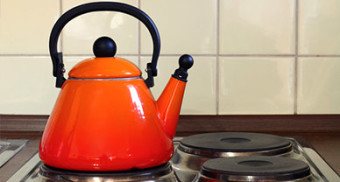

How to descale your kettle: 7 home remedies


What to do if ants appear in the apartment?


Which cookware is suitable for induction hobs and how to choose it?


How to clean a silver chain - top 5 remedies
How to keep roses
Delightful roses are the most demanded flowers among the gifts for women. Roses are presented in a bouquet of one or more flowers, in baskets, boxes and even hats. The forums have posted a lot of master classes on creating crafts with these fresh flowers.
Therefore, it is important to know how to preserve roses.
Preserving roses is divided into several stages:
1. Cut
Cutting begins with a selection of roses. Preference is given to slightly loose buds with leaves bent down. Cutting is done in the early morning. The roses are then sent to storage until the next stage.
How to store cut roses before shipping? Cut roses are stored in a cool place with an air temperature of +5 ºС for no more than 5 days. Roses are wrapped in paper and immersed in water to the level of buds.
2. Carriage
Before transportation, the stems of flowers are wrapped in paper or a damp cloth. Then the roses are packed. On the way, flowers are transported in such a way that the flowers do not fall under the sun's rays or cold air.
3. Preservation in a vase
Having received a bouquet of royal flowers, every woman thinks about how to keep roses in a vase for the longest time.
This question "How to keep roses in a vase" is answered by professional florists. Florists advise the following:
- Cut the stems obliquely under water by 3 cm;
- Tear off the lower leaves to the level of setting in the water;
- Use disinfected water;
- Add special flower products or sugar to the water;
- Place the bouquet in a cool, draft-free place, exclude direct sunlight;
- Change the water every day, while washing the stems;
- Spray the leaves and outer petals of the roses;
- When wilting, place flowers in cold water for 10 hours.
4. Drying
Having received roses as a gift, you can try to keep them as a keepsake. The main conservation method is drying.
Roses are dried by the following methods:
- Natural - hanging roses on the stem with buds down in a ventilated place;
- Sand - each petal is sprinkled with sand in a cardboard box;
- Glycerin - roses are preserved by slow immersion in a solution of glycerin in a ratio of ½ to water.
Dried roses will not lose their beauty even if you go on vacation.
In addition to roses, there are many other flowers in the bouquet that need to be preserved.
How to keep a bridal bouquet and boutonniere
The wedding bouquet is the main accessory in the hands of the bride. Keeping the bouquet in its original form - fresh and chic - from the moment of its creation until the end of the holiday is an important task.
Read more about wedding floristry in a separate article.
Professionals know how to properly store this flower bouquet in the store. But how to keep it after purchase? Florists give the following recommendations:
1. Avoid temperature extremes.
Any drafts and sharp temperature fluctuations lead to the death of flowers. If in summer the bouquet can be placed in a cool, windy place, then in winter flowers need to slowly get used to the cold when transferred from a warm room to the street. To prevent the bouquet from withering, it is gradually transferred from a warmer room to a cooler one, and then only taken out of the house.
2. Store the bouquet with care in the refrigerator if it was brought in the evening before the celebration.
Improper storage will lead to blackening of the petals of the buds. The optimum storage temperature is 5-7 ° C, except for hydrangeas and exotic flowers.
These flowers are very moody. It is advisable to buy a bouquet with these flowers only in the morning cut with delivery in a few hours.
3. Add only special products to the water for the bouquet.
The additive Chrysal has a balanced composition, which allows you to keep the freshness of the bouquet for a long time.
The use of folk remedies such as vodka, sugar, aspirin tablets should be avoided. Their incorrect use will lead to the death of the bouquet and spoil the mood of the bride.
4. Renew cut stems.
A fresh cut improves the access of water through the channels within the plant. It is permissible to make slices only by immersing the flowers in water.
5. Do not water the bouquet from above.
Do not water the flower buds. Water, getting inside, makes them unpresentable after a while.
The groom's wedding boutonniere complements the wedding bouquet. This is the second most important flower accessory. To create boutonnieres, long-lasting and fresh flowers are chosen and processed.
The most common flowers for a small groom's bouquet are roses. The question "How to keep roses in a boutonniere longer?" asked by many brides.
Initially, florists refresh the rose by removing the outer petals, then wrap the base with a cotton pad moistened with a special solution. However, in the future, to preserve the boutonniere, florists advise:
- Keep the rose in a cold place for a while;
- Spray the rose with water without hitting the center of the bud.
Following the advice of florists on preserving flowers in bouquets, both wedding and ordinary, you will not only extend their life time, but also your good mood, admiring this beauty.
Transporting roses
After the specified period, the rose can be sent to the consumer by special transport. Conditions of transportation of roses : air temperature 2-4 ° С and relative humidity 75-80%.
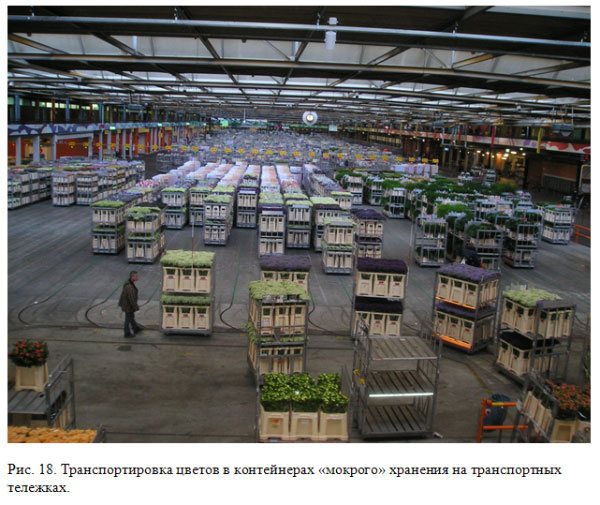

For convenience storage, transportation, color processing roses when dispensing to the consumer, more efficient use of the volume of the refrigerating chamber, it is advisable to use special transport trolleys (Fig. 18 and 19).The use of such carts makes it possible to mechanize and automate the process of shipping products to the consumer.
It is also important to carry out regular disinfection treatments of refrigerators, rooms for sorting and packaging, equipment for transporting and storing roses.
All our articles are from the heading: Greenhouses and hotbeds →→→
A source
Tricks to help extend the life of a bouquet
In addition to the basic, widespread methods of keeping roses in good shape, there are several more nuances.
So, so that the petals do not crumble, it is recommended:
- Do not remove the packaging from the presented bouquet right away, let the flowers acclimatize;
- Before placing the flowers in the vase, immerse the bouquet, along with the leaves, in water for a while. You can use a bucket or bath;
- When choosing containers, it is better to focus on ceramics, such vases keep water fresh for longer, or transparent. The walls of the latter let in sunlight, which has a positive effect on the condition of the cut plants;
- Before filling the vase, it must be sterilized. To do this, you need to boil water, and hold the container over the steam for five minutes. After that, let the vase cool and fill with water;
- Do not put roses in the kitchen. In the room where the bouquet stands, the air must be clean;
- It is better to take water from a natural source: a well or a spring. If this is not possible, you can use tap water, which has settled for three hours. The most optimal liquid temperature is room temperature;
- To maintain freshness in water, you can dissolve several tablets of activated carbon, two drops of ammonia, a couple of glucose tablets or a couple of tablespoons of sugar.
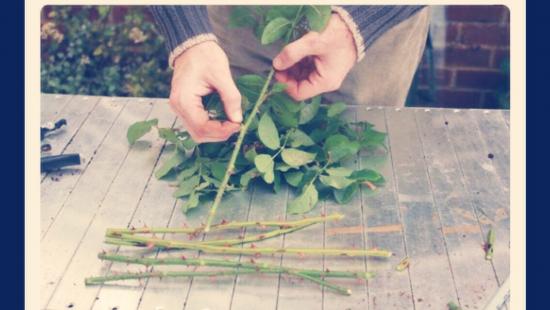

With daily water changes, it is better to move the flowers into a basin with a little water. here it is recommended to cut the stems obliquely. When moving the bouquet back into the vase, you should pinch the cuts with your finger to prevent air from entering.
Of course, all these secrets take time, but it's worth it. If you take a few minutes to care for the bouquet, the roses will delight the owners for a long time.


